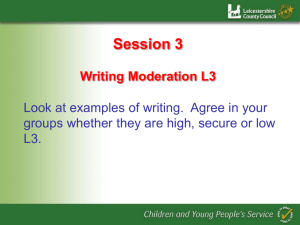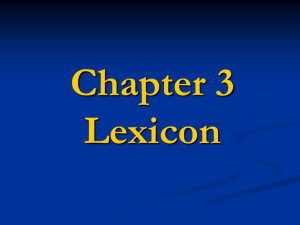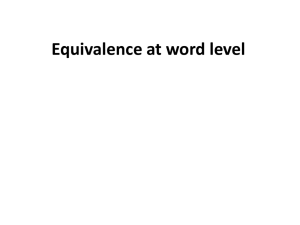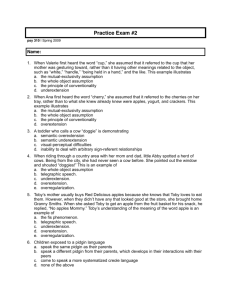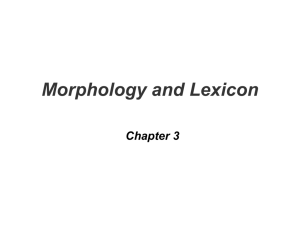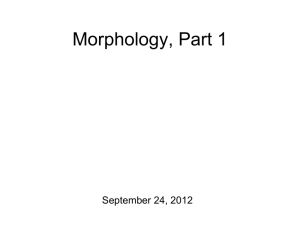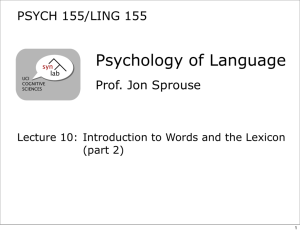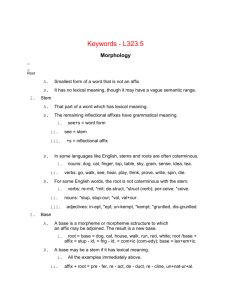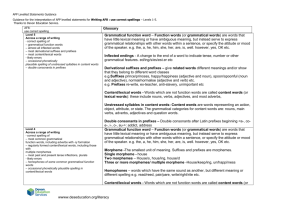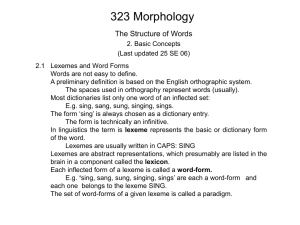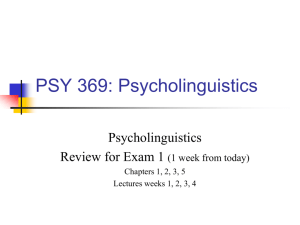Word Meaning and Mental Lexicon
advertisement
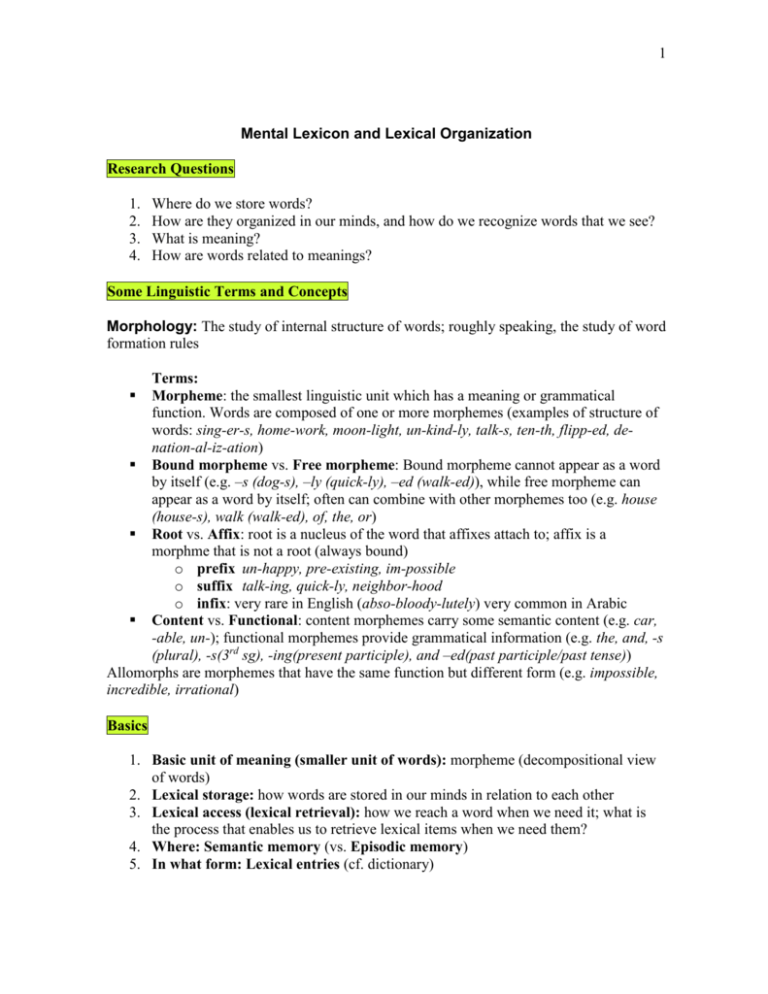
1 Mental Lexicon and Lexical Organization Research Questions 1. 2. 3. 4. Where do we store words? How are they organized in our minds, and how do we recognize words that we see? What is meaning? How are words related to meanings? Some Linguistic Terms and Concepts Morphology: The study of internal structure of words; roughly speaking, the study of word formation rules Terms: Morpheme: the smallest linguistic unit which has a meaning or grammatical function. Words are composed of one or more morphemes (examples of structure of words: sing-er-s, home-work, moon-light, un-kind-ly, talk-s, ten-th, flipp-ed, denation-al-iz-ation) Bound morpheme vs. Free morpheme: Bound morpheme cannot appear as a word by itself (e.g. –s (dog-s), –ly (quick-ly), –ed (walk-ed)), while free morpheme can appear as a word by itself; often can combine with other morphemes too (e.g. house (house-s), walk (walk-ed), of, the, or) Root vs. Affix: root is a nucleus of the word that affixes attach to; affix is a morphme that is not a root (always bound) o prefix un-happy, pre-existing, im-possible o suffix talk-ing, quick-ly, neighbor-hood o infix: very rare in English (abso-bloody-lutely) very common in Arabic Content vs. Functional: content morphemes carry some semantic content (e.g. car, -able, un-); functional morphemes provide grammatical information (e.g. the, and, -s (plural), -s(3rd sg), -ing(present participle), and –ed(past participle/past tense)) Allomorphs are morphemes that have the same function but different form (e.g. impossible, incredible, irrational) Basics 1. Basic unit of meaning (smaller unit of words): morpheme (decompositional view of words) 2. Lexical storage: how words are stored in our minds in relation to each other 3. Lexical access (lexical retrieval): how we reach a word when we need it; what is the process that enables us to retrieve lexical items when we need them? 4. Where: Semantic memory (vs. Episodic memory) 5. In what form: Lexical entries (cf. dictionary) 2 A Lexical Entry (Levelt, 1997) lemma Meaning Syntax lexeme (morphophonological form) morphology phonology Organization of Words 1. Words are stored in the lexicon with connections to other words by: a. meaning b. form (similarities in the way they are said or the way they are written) c. frequency of co-occurrence? 2. Association by meaning a. sense relations: linking words through similarities and differences of meaning: i. synonyms: words sharing a similar meaning (though complete synonymy is rare) ii. opposites: words with opposed meanings of several kinds. binary antonyms (alive/dead) gradable antonyms (hot/cold) converses (buy/sell) multiply incompatible words (summer/winter) b. semantic fields: where words are grouped according to the topic area that they fall into: buildings, household utensils, family relationships i. hyponym relationship (hyponyms: words that are members of the same category) dog is a subordinate of animal animal is superordinate of dog Within the category ANIMAL, dog and cat are co-hyponyms 3. Association by frequency: collocates (word which frequently appear together) i. co-ordination: cup and saucer, knife and fork ii. co-occurrence: heavy + smoker, post + letter, door + handle (compulsive shopper) 4. Association by sound or orthography 5. Evidence: 3 a. Word association experiments: subjects usually respond with a word associated with the stimulus in terms of meaning rather than form. This suggests that meaning associations in the lexicon are stronger than those based on similarity of pronunciation or spelling. 1 2 3 4 5 6 7 8 9 10 Butterfly moth insect wing(s) bird fly yellow net pretty flower(s) Bug Hungry food eat thirsty full starved stomach tired dog pain man Red white blue black green color blood communist yellow flag bright Salt pepper sugar water taste sea bitter shaker food ocean lake b. Priming in lexical judgment (facilitation and inhibition of the recognition of a word) i. Semantic Priming: identification of a word can be facilitated by prior exposure to a word related in meaning e.g. DOCTOR NURSE vs. BUTTER NURSE ii. Form-based priming (or form-based priming): e.g. CONTRAST CONTRACT c. Evidence from speech production Slips of the Tongue: mistakes made by speakers who produce a wrong or non-existent word instead of the one they intended to produce; evidence of how words are stored and associated in the lexicon; address all types of association effect, i.e. association by form, association by meaning, and blend white Anglo-Saxon prostitute (protestant) a routine promotion (proposal) I’ve been continuously distressed (impressed) by her don’t take this as an erection (rejection) on my part when were you last o the west ... east coast? It’s at the bottom – I mean – top of the stack of books This room is too damn hot – cold I thought westerns were where people ride horses instead of cows (cars) I don’t expose anyone will eat that My data consists moanly – maistly ... the competition is a little soughter 4 didn’t bother me in the sleast ... slightest Q: Which parts of the word seem to be kept and which replaced? Tip of the Tongue: a state where you know that the word is in your vocabulary and can even get a kind of mental image of it but cannot retrieve its form. representation of a large black beetle, used in Ancient Egypt for decoration large hairy elephant which lived on Earth during the early stages of human development to take away something owned by somebody else, often for public use and without payment an extremely small piece of mater that forms the substances of which atoms are made in Greek and Roman mythology, a creature that is half man and half horse having leaves that fall off in autumn
